
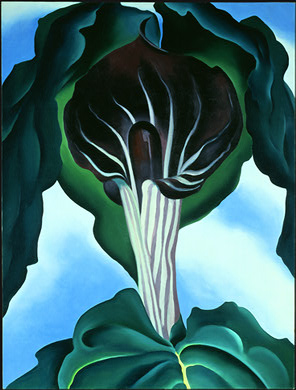 |
San Diego Jewish Academy
Art
Deconstruct to Reconstruct –
Seeing the Flower
|
Site Map | Historical and Cultural Context | Color Rules of Thumb | Quotes | Glossary | Graphic Organizers | Rules of Thumb | Co-Teachers - Doug and Melissa | Gallery | Top
E-Mail Doug at mrdoug@aznet.net
Every one has many associations with a flower. You put out your hand to touch it, or lean forward to smell it, or maybe touch it with your lips almost without thinking, or give it to someone to please them. But one rarely takes the time to really see a flower. I have painted what each flower is to me and I have painted it big enough so that others would see what I see. - Georgia O'Keeffe, catalog statement, 1926
Select a flower. Look at it closely. See each of the elements: stamen - filament, and anther; carpel - stigma, style, and ovary; petal; and sepal. Deconstruct the flower to see the parts more clearly. Rearrange the parts to create a new floral construction. See the lines. See the shapes. See the patterns. See the texture. See the color variations. See the lights and darks. See the undulations, curves, ripples - changes in the surfaces.
Top
Project
- Create a “painting” using the two-dimensional media of your choice - pencil, black or colored; crayons; pastels; markers; paint; computer software; or collage. You may mix media as well.
- Use a frame with at least one dimension no less than eight inches, and maximum dimension, your choice.
- Compose your layout, how you choose to arrange and combine parts or elements to form a whole image, in a way that shows the most powerful statement of how you see the flower. See possible compositions below.
- Display care and neatness in your work. The “painting” should look as though you value your effort. The quality of the line strokes, the neatness of the final execution, clean paper, frame with crisp lines at right angles, and the care in which you apply the media.
Top
Composition (Val Moker - http://www.valmoker.com/artistcorner-composition.html)
Composition can be defined as a means of selecting appropriate elements and arranging them within the picture space to communicate the artist's ideas, and feelings effectively to the viewer.
The 4 main elements of composition are:
- Picture area: This is the surface within the four borders of your picture that is used for the drawing or painting. The picture area will help you determine placement of objects, and how big they should be.
- Depth: This is the illusion of distance or a third dimension. Depth creates a three dimensional effect, making objects feel closer, or further away. The finished result will not appear flat on the paper or canvas if depth is created.
- Line: The line or direction the viewer's eye takes to go through the picture. The objects or forms within the picture should lead the eye to the focal point. When art is viewed, most people will begin in the bottom left corner, and continue through the picture to the right. A good composition will not allow the viewer to keep going right, all the way off the page. The viewer should be lead back into the painting in a flowing motion.
- Value: This is the lightness or darkness of an area, or a shape within the picture. It is also used to create the over-all feel of the picture.
Top
Compositional Options
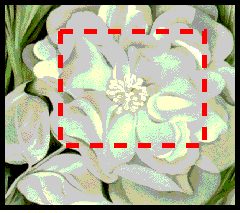
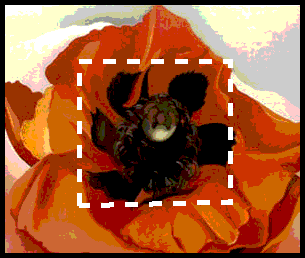
Selective Cropping – Cut off parts of the image to bring attention to the foreground, yet include supporting imagery.
Top
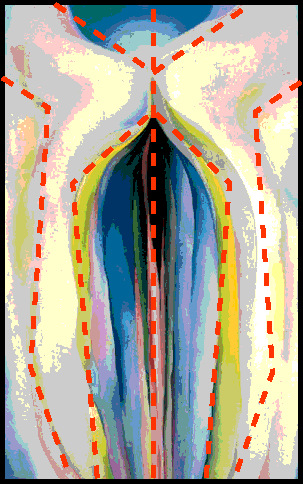
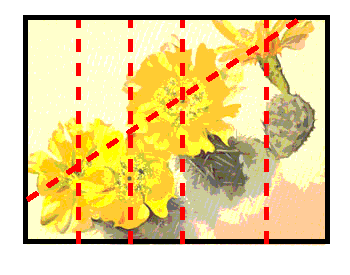
Symmetry – Divide the image equally to reflect balance.
Asymmetry – Divide the image unequally to reflect tension.
Top
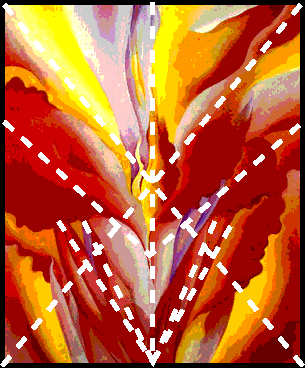
Convergence - Focus on the power of lines emanating from a single point and going out from that point.
Top
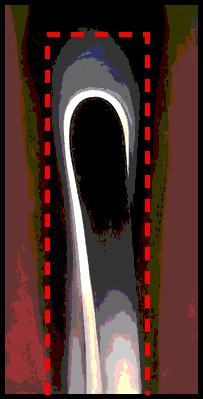
Close up - Focus on a dramatic aspect of the flower with possible emphasis on line, shape, and/or light and dark.
Top
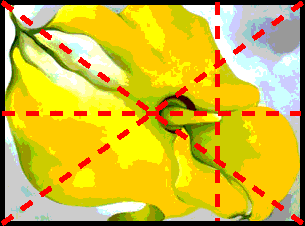
Alignment – Use horizontal, vertical, and diagonal alignments to direct the viewer’s attention through the image.
Remember You want to share how you see a flower with others by using strong compositional rules as well as care and neatness.
Top
Rubric
In the “painting” you:
Use appropriate media to bring out the qualities of the flower. (5 points)
Use a frame with at least one dimension no less than eight inches. (5 points)
Select a composition that shows the most powerful statement of how you see the flower. (20 points)
Display care and neatness in your work.(20 points)
Total possible)(50 points
Site Map | Historical and Cultural Context | Color Rules of Thumb | Quotes | Glossary | Graphic Organizers | Rules of Thumb | Co-Teachers - Doug and Melissa | Gallery | Top
E-Mail Doug at mrdoug@aznet.net
|

|
Melissa and I would like to
thank znet for
making a commitment to
education and WriteDesign.
|









